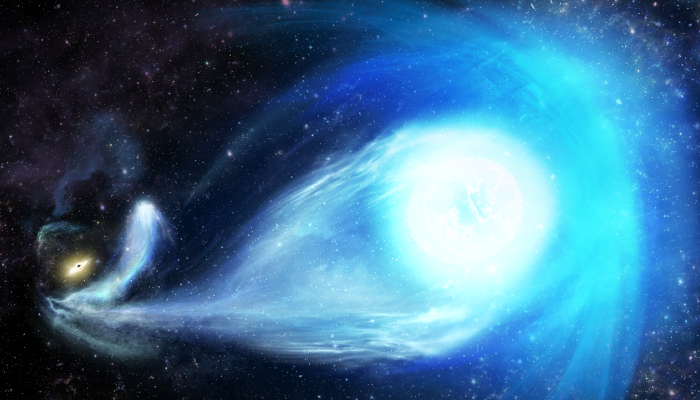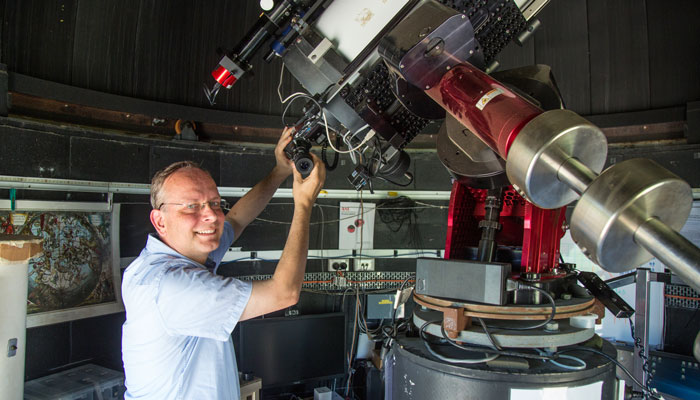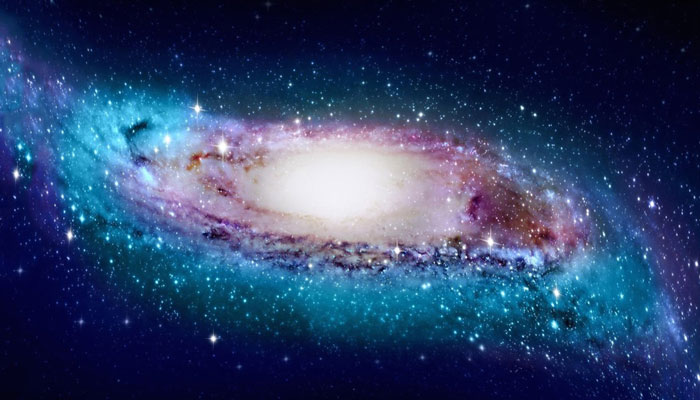In an astronomical world record, scientists have discovered a hypervelocity star that escaped the dark heart of the Milky Way nearly five million years ago and is hurtling through the galaxy at more than 6 million km/h.
Stellar finding: Researchers say it serves as an incredible example of the Hills Mechanism, proposed by astronomer Jack Hills 30 years ago. Videographer: Sophie Gidley.
Named S5-HVS1, the star, twice the mass of our own sun, was flung into space by the supermassive black hole at the centre of the Milky Way, about the time the earliest ancestors of humanity were appearing on the Earth.
It is the first strong evidence to support a 30-year-old theory that black holes can kick a star into hyper speed and ultimately out of the Galaxy, explains Macquarie University’s Daniel Zucker, a leader of the international research team that identified S5-HVS1.
Very significantly, it also gives astronomers an unprecedented line of sight into what happens in the mysterious, dust-shrouded Galactic heart – including how stars can possibly form so close to the gravitational pull of a supermassive black hole, in this case one that is 4 million times the mass of our sun.
It goes to show, when you go out to do a survey of the sky... you can also have serendipitous discoveries of interesting things that just pop out of the data.
“The centre of the Galaxy is a maelstrom of objects circling and falling into a massive black hole, Sagittarius A*, and yet there seem to be stars forming there,” says Zucker, an Associate Professor in the Department of Physics and Astronomy
“It’s a weird, bizarre place, and very hard for us to probe because there is a lot of dust between us and it; we can see things with infrared and radio waves but not necessarily with optical light.

Historic escape: An artist’s impression of S5-HVS1’s ejection by Sagittarius A, the black hole at the centre of the Galaxy. The black hole and the captured binary partner to S5-HVS1 are seen far away in the left corner of the picture, while S5-HVS1 is in the foreground, speeding away from them. Credit: James Josephides (Swinburne Astronomy Productions).
“Now we’ve got a star that seems to have formed within the region and has escaped from it and, at 29,000 light-years from Earth, is now close enough for us to study in relative detail.
“And it seems to be perfectly normal, so that should tell us something about how stars are being formed near the Galactic centre and about the conditions there.”
The dramatic end of a Galactic dosey doe
“Normal” means S5-HSV1 is a main sequence star, like our own and most other stars, that is still fusing hydrogen at its core. At 500 million years old, S5-HSV1 is halfway through its life span. For the 495 million years before its dramatic expulsion from Sagittarius A*, it would have been in a binary system with another star, the two of them orbiting each other in a Galactic dosey doe until coming too close to the black hole.
At that point, the Hills Mechanism proposed by Jack Hills in 1988 kicked in, with the black hole capturing one star of the pair and hurling the other into space at a velocity of 1800 kilometres a second.
“It has to do with the gravitational binding energy,” Zucker says of Hills’ theory. “In a binary system, a very massive object takes the place of the other star in the binary, then the remaining star is flung out. It’s like switching dance partners, but where the initial partner is thrown out at high speed. If the object replacing one of the stars is way, way, way bigger, then it will give an enormous kick to the one that’s escaping, and that is what’s happened in this case.”
A happy accident
The first hypervelocity star was identified in 2005, and fewer than 30 have been observed since.

Hurtling heavenly body: The location of the star on the sky and the direction of its motion. The star is flying away from the Galactic centre, from which it was ejected 5 million years ago. Credit: Sergey Koposov.
The fastest of them all, S5-HVS1 (moving at 1700km/s relative to the Galactic centre), was discovered with the Anglo-Australian Telescope at Siding Spring Observatory near Coonabarabran, in the NSW Central West, as well as with data collected by the European Space Agency’s Gaia space observatory.
To put S5-HVS1’s speed in perspective, our own sun moves in its orbit around the Milky Way at about 220 kilometres a second.
The data that led to its discovery were being amassed as part of the ongoing Southern Stellar Stream Spectroscopic Survey – or S5 – which is observing the streams of stars on the edges of the Milky Way that have been formed by orbiting dwarf galaxies and star clusters torn apart by the Galaxy’s tidal forces.
"As a side project”, Zucker says, “Professor Sergey Koposov of Carnegie Mellon University in Pennsylvania was examining spectra from the S5 survey to look for stars with high radial velocities. He was very surprised to find that one star - which he dubbed S5-HVS1 - was moving away from us at a speed of over 1000 km/s!”
Other members of the S5 leadership team include Kyler Kuehn, from Macquarie-based Australian Astronomical Optics and Lowell Observatory, Ting Li from Carnegie Observatories and Princeton University, and Geraint Lewis from the University of Sydney.
“It goes to show, when you go out to do a survey of the sky, in addition to the science that comes from what you’re planning to do, you can also have serendipitous discoveries of interesting things that just pop out of the data,” Zucker says.
He says it’s highly unlikely the hurtling star will collide with another heavenly body, considering the galaxy is mostly empty space. Ultimately, it will shoot out of the Milky Way and into deep space – a very long time from now, given it will take about 180 years to travel one light year.
“And who knows what will happen with it then.”
- Daniel Zucker is an Associate Professor in the Department of Physics and Astronomy.



